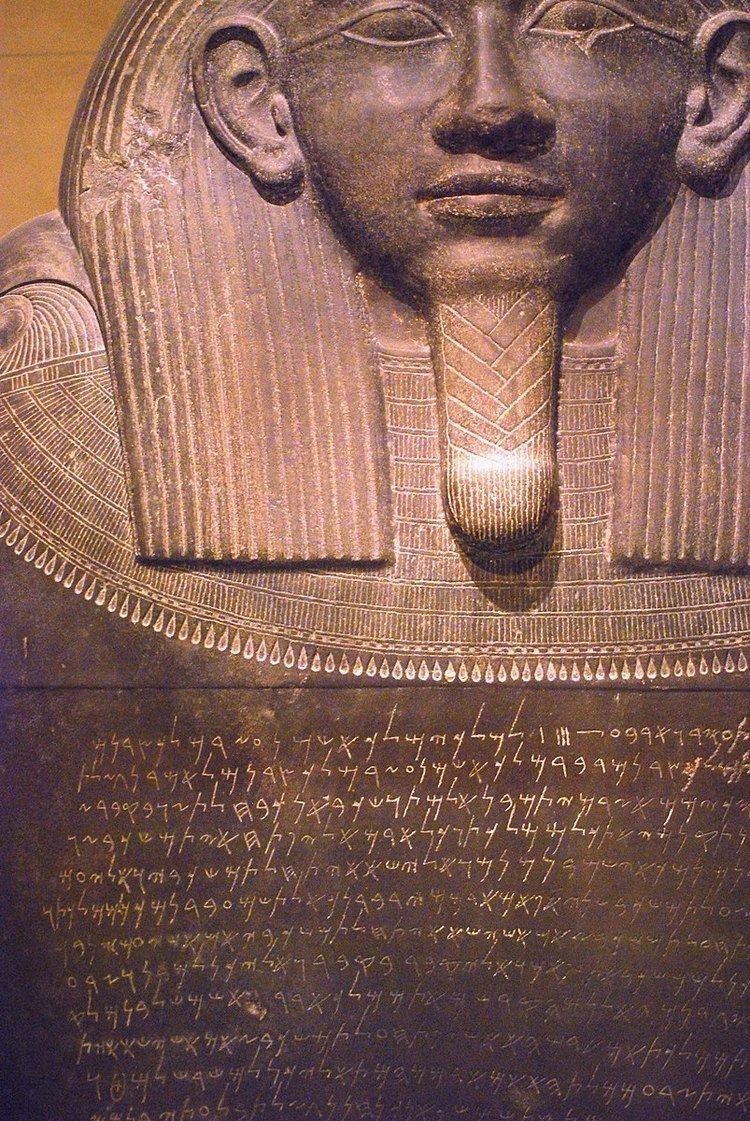Material Amphibolite Writing Phoenician language Discovered 1855 | Size 2.56 x 1.25 m Created c.500 BCE Present location Louvre | |
 | ||
The sarcophagus of Eshmunazar II (Phoenician: ʾšmnʿzr), a Phoenician king of Sidon and the son of King Tabnit (possibly the Greek Tenes), was created in the early 5th century BCE. It was unearthed in 1855 at a site near Sidon and is now in the Louvre. The sarcophagus was likely created in Egypt, being carved from amphibolite from Wadi Hammamat.
Contents
The inscription states that the "Lord of Kings" granted the Sidonian kings territory in Land of Israel: Dor, Jaffa, the Plain of Sharon.
The inscription is the first discovered in the Phoenician language from the area known as Phoenicia.
Discovery
The sarcophagus was discovered in the Necropolis of Magharat Abloun ("Cavern of Apollo") on 20 February 1855 by Aimé Péretié, chancellor of the French consulate of Beirut. It was purchased in the same year by Honoré Théodoric d'Albert de Luynes, who donated it to the Louvre.
Inscription
The sarcophagus bears a 22 line inscription, known as KAI-14, written in the Phoenician Canaanite language, in the Phoenician alphabet. The inscription identifies the king inside and warns people not to disturb his repose.
The language used in the inscription is a Canaanite dialect mutually intelligible with Biblical Hebrew.
As in other Phoenician inscriptions, the text seems to use no, or hardly any, matres lectionis. As in Aramaic, the preposition "אית" is used as an accusative marker, while "את" is used for "with".
Translation
The translation below is based on that by Julius Oppert, amended with the help of a more recent translation in Prichard & Fleming.
- In the month of Bul, in the fourteenth year of the royalty of King Eshmunazar, King of the two Sidons,
- son of King Tabnit, King of the two Sidons, King Eshmunazar, King of the two Sidons, said as follows: I am carried away,
- before my time, the son of (few) days, an orphan, the son of a widow. And I am lying in this coffin, and in this tomb,
- in the place which I have built. Whoever you are, of royal race or an ordinary man, may he not open this resting-place, and
- may he not search after anything, for nothing whatsoever has been placed into it. May he not move the coffin in which I am resting, nor carry
- me away from this resting-place to another resting-place. Whatever a man may tell thee, do not listen to him: For every royal race and
- every ordinary man, who will open this resting-place or who will carry away the coffin where I repose, or who will carry me
- away from this resting-place: may they not have any funeral couch with the shades (the Rephaïm), may they not be buried in a grave, and may there not be a son or offspring
- to succeed to them, and may the sacred gods abandon them to a mighty ruler who (might) rule them, in order
- to exterminate that royal race or man who will open this resting-place or who will take away
- this coffin, and also the offspring of this royal race, or of that ordinary man. There shall be to them no root below, nor
- fruit above, nor living form under the sun. For I am carried away, before my time, the son of
- (few) days, an orphan, the son of a widow. For I, Eshmunazar, King of the two Sidons, son of
- King Tabnit, King of the two Sidons, the grandson of King Eshmunazar, King of the two Sidons, And my mother Amoashtart,
- the Priestess of Astarte, our mistress, the Queen, the daughter of King Eshmunazar, King of the two Sidons: It is we who have built the temple of
- the gods, and the temple of Astaroth, on the seaside Sidon, and have placed there (the image of) Astaroth in Shamem-Addirim. And it is we
- who have built a temple for Eshmun, the holy prince, at the purpleshells River on the mountain, and have established him in Shamem-Addirim. And it is we who have built the temples
- for the gods of the two Sidons, in the seaside Sidon, tile temple of Baal-Sidon and the temple of Ashtart-Shem-Baal. Moreover, the Lord of Kings gave us
- Dor and Joppa, the mighty lands of Dagon, which are in tile plain of Saron, in accordance with the important deeds which I did. And we annexed them
- to the boundary of the land, that they would belong to the two Sidons for ever. Whoever you are, of royal race or ordinary man, may he not open it
- and may he not uncover me and may he not carry me away from this resting-place. Otherwise,
- the sacred gods shall abandon them and exterminate this royal race and this ordinary man and their offspring for ever.
